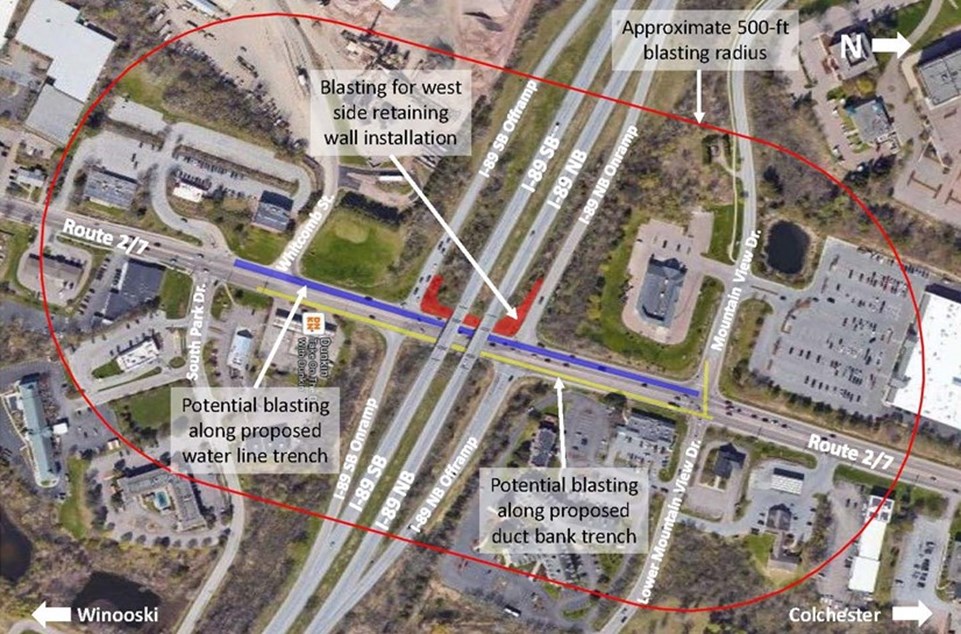Blasting Overview March 22, 2023 - Updated
Blasting Activities
The Exit 16 DDI will be conducting drilling and blasting activities (blasting) to remove hard rock and ledge below the surface of the ground that cannot be removed using mechanical methods. Blasting is anticipated to begin the week of April 3rd and continue for approximately two months. The start of blasting activities is weather dependent. Blasting will take place along U.S. Route 2/7 (U.S. 2/7) between South Park Drive and Mountain View Drive. Up to two blasting events will take place a day and will be restricted to weekdays, Monday through Friday (excluding holidays) between the hours of 9:00 AM and 2:00 PM, the exact time of each blast will vary.
Blasting hours have been extended to allow for additional blasting operations between 6:30 a.m. and 7:00 a.m. This extension allows crews to prepare for daily blasting operations during off-peak hours when traffic volumes are low.
Ledge has been located at depths as shallow as 4 feet beneath the roadway surface throughout the area. Blasting activities are required to facilitate the installation of the west side retaining wall off of the roadway behind the I-89 bridge pier (shown in red) and the relocation of underground utilities within U.S. 2/7 including the waterline (shown in blue) and electrical and telecommunication utility duct bank (shown in yellow). Portions of the waterline will be relocated to depths of over 12 feet beneath the roadway surface.

ABOUT BLASTING OPERATIONS
Who will be conducting the blasting operations?
The contractor, S.D. Ireland (SDI), has hired Maine Drilling and Blasting (MDB) as its blasting subcontractor. MDB is a family-founded business started in 1966 in Gardiner, Maine that services over 16 states throughout the Northeast and Mid-Atlantic regions from Maine to Georgia. For over half a century, Maine Drilling and Blasting has specialized in drilling and blasting operations cultivating a team of highly skilled staff with a commitment to safety. Maine Drilling and Blasting has performed over 2 million controlled blasts and is recognized as one of the safest and most experienced providers throughout the east coast.
What precautions are being taken?
SDI and MDB are currently documenting the structural conditions before drilling and blasting. Pre-blast surveys are being conducted for all adjacent properties and structures within 500 feet of the blasting zone. Seismographs are deployed throughout the project area to record vibrations and ensure vibration limits are not exceeded. SDI and MDB will follow a strict blasting procedure designed with safety in mind. The blasting zone will be cleared of all users before each blasting event using road and sidewalk closures and rolling roadblocks. Access to the blasting zone will be restricted until a blasting specialist deems the area safe for reentry. Detailed information on the blasting procedure and traffic impacts can be found below.
What to expect?
A blasting event will consist of a series of small blasts. These blasts will occur underground and be contained using blasting mats. There will be no visible explosions such as fireballs, flying debris, or major dust clouds. Small rumblings and vibrations in the ground may be felt depending on the proximity to the blast location. The blasts will not be loud and will not cause buildings to shake or rattle.
What is the blasting procedure?
Before blasting, vehicular, pedestrian, and bicycle traffic will be temporarily restricted from the blasting area. Audible signals will be used to notify the public of an upcoming blasting event which includes three whistles to indicate a five-minute warning, two whistles to indicate a one-minute warning, and one whistle to indicate the all-clear. The all-clear will be followed by the blasting event. After each blasting event, a blasting specialist will clear the area before allowing vehicular, pedestrian, and bicycle traffic to reenter.
How will blasting impact traffic?
U.S. Route 2/7
Four minutes before each blasting event, Uniformed Traffic Officers (UTOs) and barricades will be placed at either end of the blasting zone on U.S. 2/7 and the I-89 offramps to prevent vehicles, pedestrians, and cyclists from entering the blasting zone. The blasting zone is anticipated to be between South Park Drive and Mountain View Drive, however, this area will be refined based on the specific blasting location. Flaggers will be present at adjacent businesses and sideroads to prevent pedestrians, cyclists, and vehicles from entering the area. Once the area is secured, the blasting event will take place. After each blasting event, a blasting specialist will clear the area before allowing users to reenter the blasting zone. The I-89 interstate offramps will be cleared before U.S. 2/7 traffic is released. Wait times are not anticipated to exceed 10 minutes.
Interstate 89
Four minutes before each blasting event, UTOs and SDI construction vehicles will initiate a rolling roadblock between Exit 14 and 17 along I-89 northbound and southbound. Rolling roadblocks slow traffic down to create a gap in traffic to allow the blasting event to take place safely. A pilot vehicle will follow the last vehicle impacted by the rolling roadblock to inform the team once the area in the blasting zone is secured. The rolling roadblock will continue until the hard stop location is reached. To learn more about rolling roadblocks, watch this video created by the Kansas Turnpike.
All users should expect delays and plan ahead.
Where can I find real-time information on blasting?
Weekly blasting information will be included in the weekly Construction Updates. Daily blasting updates will be posted to the Project Website Homepage under Project Updates and on the Interactive Map.
